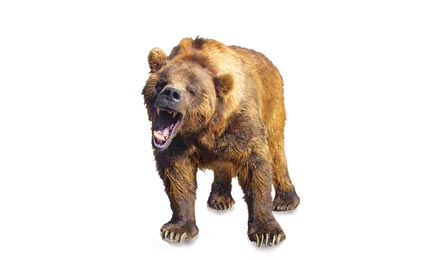Backpacker Bible: See More Wildlife

'A Grizz (istockphoto.com)'
Thou Shalt Not: Surprise a grizzly.
If you encounter a bear that hasn’t noticed you, stand tall and talk in a loud, calm voice. Reach for your pepper spray, not your camera.
» Stop at vantage points overlooking (and downwind of) meadows, watering holes, and travel corridors, like game trails.
» Keep a safe distance. If the animal pays more attention to you than anything else, you’re too close.
» Target overcast days, when many animals are most active, and windless weather, since your scent won’t travel.
» Keep binoculars and camera handy. Rooting for them in your pack will scare animals off.
» Practice “scatter vision.” Keep your eyes moving without letting them settle on one focal point. This improves your ability to spot motion—or just a part of an animal, like a tail or antler—over a wide area.
» Observe prey animals for signs.
If all the elk in a herd suddenly look in one direction, be on alert for a glimpse of their predator.
» Sit quietly and watch at dawn and dusk, when many animals are most active. Station yourself near water holes and in transition zones, like the edges of forests and meadows.
» Ask local land managers where wildlife is congregating. Learn which plants animals are foraging for, and where they grow.
» Sneak up ridges. Before cresting a hill, slow down, get quiet, and peek over the edge.
{ Revelation }
Do Not Disturb
I’ve seen a grizzly sow and two cubs from 30 yards away in Glacier National Park. That got my heart pumping, to be sure. I once encountered a mountain lion on a Northern California trail, and I still shudder to think of what it could have done with those huge claws had it been hungry. But neither experience prepared me for the terror of waking up in the middle of the night with a skunk’s butt in my face.
I was in California’s Trinity Alps, leading teens on a weeklong trek during which they learned backpacking skills. All 12 of us—10 kids and two guides—had laid our bags out under the stars. It was a mild night, without a hint of clouds, and we had no problem conking out after a big day on the trail. But a small scratching noise woke me after midnight; I opened my eyes and there was a skunk tail, unmistakable in the moonlight, waving slowly up and down about six inches away. The skunk inspected every square inch of the ground around my head, searching for any crumbs we might have dropped. It sniffed at the dirt by my left ear, its tail still bobbing slightly. I knew we were in no real danger, of course, but the thought of taking a direct hit to the face was enough to cause panic to rise in my chest, and the vision of every kid under my watch getting sprayed was not pleasant either. I was not about to startle that skunk.
Until that moment, I thought I knew how to be quiet around wildlife. But there’s a difference between not talking and being utterly, truly silent. I willed myself to breathe slowly, through my nose. I relaxed my body, starting at my feet and consciously willing every muscle and bone to go dormant. I watched the skunk move to the nearest prone body and start its search again, but I only moved my eyes to track its progress, keeping my head still. I remained that way, mesmerized and motionless, as the skunk investigated the rest of our camp. It left before anyone else woke up—thankfully, I had learned to be quiet. Really quiet. Follow these tips, and you will, too:
» Breathe through your nose (unless you’re congested or moving fast, and need more air).
» Stalk wildlife early or late, when the ground is wet with dew, or after a rain; moisture softens leaves and twigs so they’re less noisy underfoot.
» Step slowly, knees bent, rolling forward from heel to toe. Slip large wool socks over your boots to muffle footsteps.
» Wear close-fitting clothes that won’t rub and swish. Make sure nothing is loose and hanging, even the ends of shoe laces.
» Avoid strong-scented lotions, sunscreen, and bug repellent.
» Mimic the way small animals move, in short, irregular bursts, not in a steady pattern.
» Practice walking quietly at home, around your pets. If you can sneak up on a dog or cat, you’re doing well.
—Dennis Lewon